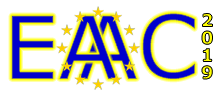Speaker
Description
A typical laser-plasma accelerator (LPA) is driven by single, relativistic laser pulse from terawatt or petawatt-class lasers. Recently, there have been simulation studies on the use of two synchronized ultrashort relativistic co-propagating two-color laser pulses (CTLP) for LPA research. Here, we present experimental results from the first LPA driven by CTLP where we observed a significant distinction in the electron energy spectra as compared with the results from a standard LWFA driven by a single laser pulse of equivalent power. Those results have been further confirmed in a real-application experiment, where the electrons from the CTLP scheme were used in a bremsstrahlung-based positron generation configuration which led to a distinctive spectrum for the positron beam energy spectra as well. Numerical simulations suggest that the trailing Second Harmonic (SH) relativistic laser pulse is capable of sustaining the acceleration process for a much longer distance after the preceding fundamental laser pulse has been depleted in the plasma. Therefore, our experimental work demonstrates significant advances in driving LPAs by two-color laser pulses.

